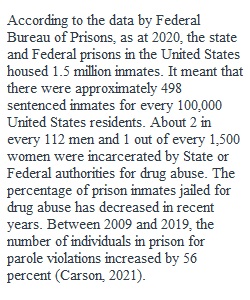


Q Drug offenders are prevalent in the U.S. criminal justice system. Due to the connection between their drug use and criminal activity, the criminal justice system has developed new approaches to dealing with drug offenders. This activity addresses module outcomes 1 & 2. Upon completion of this activity, you will be able to: • MO1: Identify the prevalence of offenders with drug problems in the U.S. criminal justice system. (CO3) • MO2: Explain the role of drug courts as an alternative to traditional courts. (CO4) There are over 3,000 drug courts in the United States. These specialized courts attempt to address offenders’ drug use and subsequent criminal activity through intensive monitoring and treatment services. Respond to the following: • Briefly describe the extent of the offender population that is involved with drug use. • Identify the strengths and weaknesses of drug courts as a way to address the needs of drug offenders. • Explain whether you support the use of drug courts. Justify your response. Post your primary response by Thursday, 11:59 PM EST. Each primary discussion needs to be at least 200 words in length with citations and references to support your position. Read and respond to the conclusions drawn by at least two of your classmates by Sunday, 11:59 pm EST. Remember to read the feedback to your own major postings and reply to it throughout the module. Consult the Discussion Posting Guide for information about writing your discussion posts. It is recommended that you write your post in a document first. Check your work and correct any spelling or grammatical errors. When you are ready to make your initial post, click "Reply." Then copy/paste the text into the message field, and click "Post Reply." This is a “post first” discussion forum. You must submit your initial post before you can view other students’ posts. To respond to a peer, click “Reply” beneath her or his post and continue as with an initial post. This discussion will be graded using the SPS Default Discussion Rubric. Please review this rubric, located on the Rubrics page within the Start Here module of the course, prior to beginning your work to ensure your participation meets the criteria in place for this discussion. All discussions combined are worth 20% of your final course grade.
View Related Questions